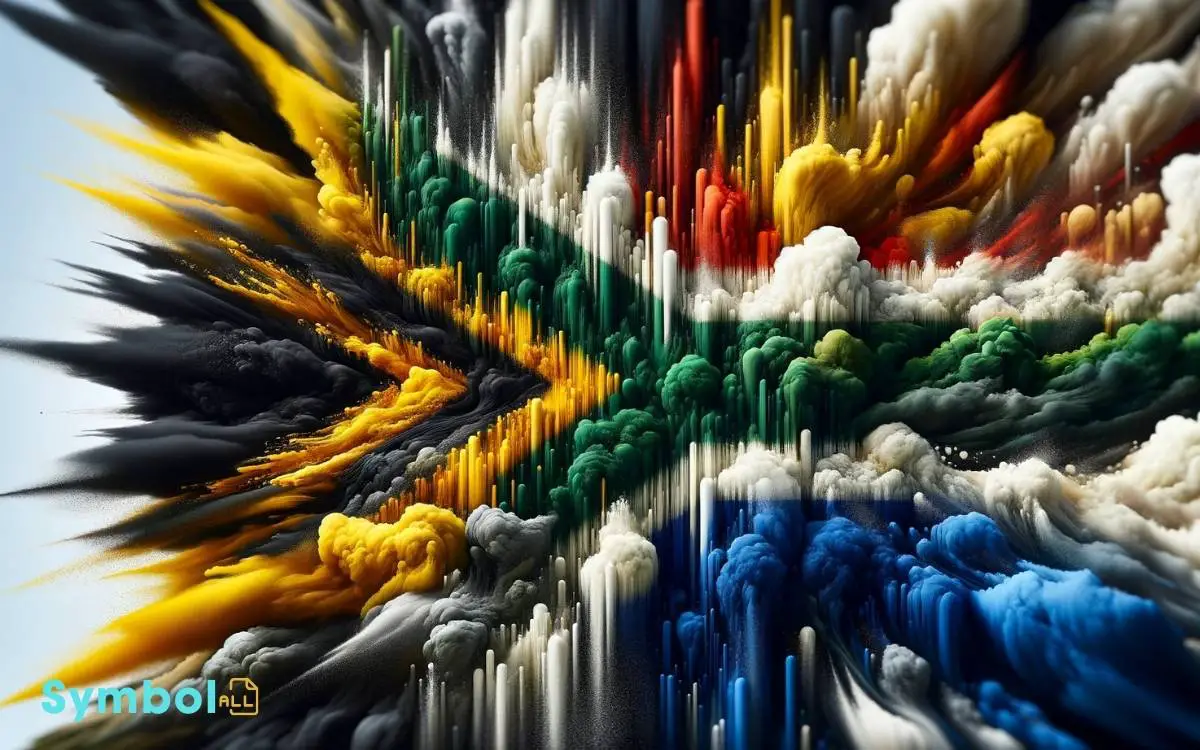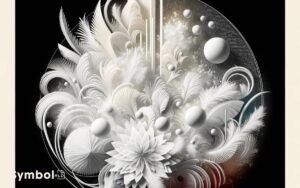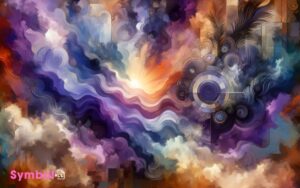What Do the Colors of the South African Flag Symbolize?
The colors of the South African flag symbolize the nation’s rich heritage and unity. Black, green, and yellow reflect the black majority’s struggle for freedom and hope.
The red, white, and blue nod to colonial history and white South Africans’ contributions. The Y-shape signifies the merger of diverse groups, pointing towards unity, democracy, and reconciliation.
Green represents the land’s fertility and hope, gold for prosperity and culture, black for unity, red for bravery and sacrifice, and blue for endless possibilities.
Each color narrates a part of South Africa’s journey, inviting you to explore the depth of its identity further.

Key Takeaway
The Essence of the Flag
Understanding the essence of the South African flag involves delving into its rich colors, each symbolizing the country’s diverse heritage and the unity of its people.
Black, green, and yellow are drawn from the African National Congress (ANC) flag, representing the nation’s black majority and their struggle for freedom.
Red, white, and blue echo the colors of the British and Dutch flags, acknowledging the colonial history and the contributions of white South Africans.
The Y-shape, converging into a single horizontal band, illustrates the convergence of diverse elements within the society, moving forward as one.
This design isn’t just an aesthetic choice; it’s a deliberate representation of the nation’s journey towards unity, democracy, and reconciliation, encapsulating a vision for a harmonious and inclusive future.
Historical Context
To grasp the historical context of the South African flag, it’s imperative to explore the turbulent yet transformative periods that shaped the nation, from colonial dominance to the dawn of democracy.
| Period | Event | Impact on Nation |
|---|---|---|
| 1652-1806 | Dutch and British Colonization | Laid the foundations of racial segregation and exploitation |
| 1948-1994 | Apartheid Era | Institutionalized racial discrimination and segregation |
| 1994 | End of Apartheid/First Elections | Ushered in democracy and reconciliation |
Symbolism of Green
The vibrant green stripe across South Africa’s flag symbolizes the nation’s fertile land and its hope for growth and renewal amidst its diverse cultures.
This color doesn’t just point to the physical richness of the soil that sustains agriculture and prosperity; it also signifies the rejuvenation of ideas and unity within the country.
Green represents the aspiration for harmony among its people, echoing the natural balance found in its landscapes.
By integrating this color into the national flag, South Africa articulates a vision where its environmental wealth and cultural diversity blend into a cohesive and prosperous society.
It’s a reminder that growth both literal and metaphorical is at the heart of the nation’s identity, pushing it toward a future filled with possibility and inclusivity.
The Significance of Gold
Shimmering with promise, gold in South Africa’s flag captures the country’s wealth, both material and spiritual, symbolizing prosperity, success, and the richness of its diverse cultures.
This color isn’t just a nod to the natural resources that have fueled South Africa’s economy, particularly its gold mines, but also a sign of hope for a future filled with wealth and opportunity for all its people.
It reflects an aspiration towards unity and growth, transcending beyond mere economic gains. Analyzing its placement within the flag, gold bridges the gap between the other colors, suggesting a harmonious blend of diverse elements within the nation.
It’s a confirmation of South Africa’s journey towards forging a united identity from a fragmented history, embodying optimism and a collective pursuit of progress.
Understanding Black
As you explore the black color on the South African flag, you’ll find it’s more than just a hue; it’s a powerful symbol of unity, echoing the country’s complex history.
This shade represents the convergence of diverse cultures and the overcoming of historical challenges, binding the nation together.
With its modern interpretations, black also reflects the ongoing journey towards unity and the resilience of the South African spirit.
Black Represents Unity
Understanding the color black within the context of the South African flag, it’s key to recognize that it symbolizes unity, reflecting the nation’s endeavor towards coming together across diverse backgrounds.
This aspect isn’t merely delving deep into the essence of what the nation aims for: a cohesive, inclusive society where differences aren’t just tolerated but celebrated.
The black color, thus, isn’t just a hue but a profound statement. It advocates for the amalgamation of various ethnicities, cultures, and identities into a unified whole.
It’s a reminder that unity isn’t about erasing differences but about embracing them to build a stronger, united country.
This symbolism is essential in understanding the flag’s overall message and the values South Africa stands for.
Historical Significance
Delving into the historical significance of the color black on the South African flag reveals its deep roots in the nation’s struggle for unity and reconciliation.
This color, more than just a design element, symbolizes a critical period in South Africa’s past. It’s a poignant reminder of the hardships and the resilience of its people during times of division and apartheid.
| Aspect | Significance | Context |
|---|---|---|
| Apartheid | Oppression | Historical |
| Liberation | Resilience | Cultural |
| Unity | Reconciliation | Sociopolitical |
Understanding black within this context invites you to appreciate the depth of the nation’s journey towards peace and equality.
It’s not merely a color but a reflection of the enduring spirit of South Africa’s people and their collective aspiration for a harmonious future.
Modern Interpretations
Today’s perspective on the color black in the South African flag invites us to explore its evolving significance in the nation’s identity and collective memory.
Initially representing the country’s black population and their struggle for freedom, black has grown to symbolize resilience, strength, and the rich soil that sustains life in South Africa.
As you investigate further, you’ll find that black echoes the profound journey from apartheid to democracy, reflecting a commitment to unity and progress. It’s a reminder of the hardships overcome and the diverse cultures that thrive together under one nation.
This nuanced interpretation encourages a broader appreciation of black’s role in symbolizing not just a part of the population, but the collective spirit and enduring hope of all South Africans.
The Meaning Behind White
In the South African flag, the color white symbolizes the path toward unity and peace among the nation’s diverse peoples.
This choice is deeply significant, representing more than just a visual break in the flag’s vibrant palette. It’s a deliberate nod to the country’s complex history, acknowledging the necessity of harmony between different racial and cultural groups.
White serves as a reminder of the commitment to forge a shared future, transcending past divisions. It’s strategically placed within the flag to act as a mediator, bridging gaps and encouraging dialogue.
By understanding this, you’re not just seeing a color; you’re witnessing a nation’s ongoing journey towards inclusivity and reconciliation, a demonstration of its resilience and hope.
The Story of Red
Moving from the peace and unity symbolized by white, let’s explore the vibrant red in the South African flag, which carries its own profound narrative.
Red embodies the bloodshed and sacrifices made during the struggle for freedom. It’s a poignant reminder of the lives lost and the fierce battles fought against oppression and apartheid.
This color isn’t just a reflection of past conflicts; it’s also a tribute to the resilience and bravery of the South African people. Through bloodshed, they achieved liberty and laid the groundwork for the nation’s rebirth.
As you gaze upon the red in the flag, it’s a call to remember the cost of freedom and the enduring spirit of those who fought for equality and justice in South Africa.
Interpreting Blue
Shifting our focus to the serene blue on the South African flag, you’ll find it symbolizes the depth of the sky and the vastness of the ocean, reflecting the country’s infinite possibilities and aspirations.
This color choice isn’t arbitrary; it’s deeply imbued with meaning, pointing to both geographical and metaphorical expansiveness.
South Africa, with its rich maritime history and strategic positioning at the tip of the African continent, has always looked towards the blue horizon as a frontier of opportunity and growth.
The blue in the flag, hence, isn’t just a visual element. It’s a narrative device, encapsulating the nation’s collective ambition and its people’s desire to reach beyond the immediate, towards the boundless prospects that lie ahead. This profound symbolism resonates deeply, reminding citizens of the shared journey towards progress and unity. Much like the colors of the Italian flag evoke rich cultural heritage and unity, the blue in this flag serves as a poignant reminder of the ideals that bind the nation together. It stands as a beacon of hope, urging the people to embrace both their history and the limitless future that awaits them.
Unity and Diversity
Building on the thematic depth represented by the color blue, let’s explore how the South African flag’s design and palette further embody the nation’s commitment to unity and diversity.
The flag’s Y-shape, merging distinct colors, symbolizes the convergence of diverse elements within the nation, uniting different cultures, beliefs, and histories towards a shared future.
This design choice reflects a deliberate effort to represent South Africa’s complex identity, where each color doesn’t just stand alone but also merges and interacts with others, creating a cohesive whole.
It’s a visual metaphor for the country’s aspirations towards unity amidst diversity, highlighting the principle that differences don’t divide but rather enrich and strengthen the national fabric.
This symbolism encourages a deeper appreciation of South Africa’s collective identity, fostering a sense of belonging and unity among its people.
A New Dawn
As we delve into the theme of ‘A New Dawn‘, it’s crucial to understand how the South African flag’s evolving symbolism signifies a significant departure from a past marked by division, indicating an era of reconciliation and collective ambition.
This transformation isn’t just superficial; it’s deeply symbolic of the nation’s journey towards unity.
You’ll see that each color now carries a burden of history, yet points ahead with hope. Black, green, and yellow, previously linked to the African National Congress, alongside red, white, and blue, mirroring colonial and Boer Republic flags, blend into a coherent visual storyline.
This amalgamation underscores a dedication to create a shared future, surpassing historical conflicts.
It’s a visual proof of the resilience and flexibility of the South African spirit, embracing diversity as a strength.
The Y-Shaped Design
The Y-shaped design of the South African flag embodies unity, guiding the nation’s diverse elements towards a convergent future.
This unique configuration isn’t just aesthetically pleasing; it’s a profound expression of the country’s journey from apartheid to a democracy that values all its citizens equally.
The symbolism behind the Y-shape can be broken down into three key aspects:
- Convergence: It represents the coming together of different paths into a single, unified direction.
- Diversity: The branches of the Y signify the nation’s cultural, linguistic, and racial diversity.
- Future Orientation: Pointing forward, it symbolizes progress and the collective movement towards a better future.
Analyzing this design reveals a deep commitment to unity in diversity, a fundamental principle upon which South Africa is rebuilding itself.
Flags Within a Flag
Delving into the South African flag’s design, you’ll uncover a nuanced portrayal of unity, where individual flags of historical significance are seamlessly integrated, symbolizing the nation’s complex heritage and journey towards inclusivity.
This integration isn’t just a merging of colors but a thoughtful amalgamation of elements from the flags of the African National Congress, the South African Party, and the British Union flag among others.
Each element represents a different facet of South African society, from the struggle for freedom to colonial history, encapsulating a narrative of reconciliation and coexistence.
It’s a visual dialogue, reminding you that the nation’s identity is woven from diverse threads, each carrying its own historical weight and significance, yet together forming a cohesive and harmonious whole.
Cultural Reflections
Every color and symbol on the South African flag reflects deep-rooted cultural narratives that have shaped the nation’s identity.
This vibrant banner is more than just a national emblem; it’s a tapestry of stories, each thread woven from the country’s diverse heritage. The flag’s design and colors are a visual representation of South Africa’s rich cultural landscape.
Three key aspects underscore its cultural significance:
- Unity in Diversity: The flag’s interlocking colors symbolize the nation’s commitment to unity amidst cultural diversity.
- Historical Narratives: Each hue echoes the country’s tumultuous history, celebrating both indigenous roots and the paths toward freedom.
- Cultural Pride: The flag stands as a beacon of cultural pride, reminding citizens and the world of South Africa’s unique cultural identity.
Political Representations
Beyond its vibrant aesthetics, South Africa’s flag carries profound political symbolism, reflecting the nation’s journey towards democracy and the aspirations for a harmonious future.
Its design and colors are not just for decoration; they’re imbued with the political history and the collective aspirations of the South African people.
Let’s break down these colors to understand their political significance:
| Color | Political Representation |
|---|---|
| Black | Represents the people, specifically acknowledging the black majority |
| Green | Symbolizes the land, the fertile farms, and the importance of agriculture |
| Yellow | Stands for the natural resources, particularly gold, that’s central to South Africa’s economy |
| Red | Reflects the people’s sacrifices and the bloodshed during the struggle for freedom |
Each color is a chapter from the nation’s political narrative, together weaving a story of resilience, unity, and progress.
Hope for the Future
In analyzing the colors of the South African flag, it’s evident that they not only recount the past but also cast a vision of hope and unity for the nation’s future.
The flag’s design and colors are a deliberate choice, symbolizing a move towards inclusivity and optimism.
This embodiment of hope is essential for understanding the flag’s significance:
- Gold: Represents the wealth and prosperity that’s desired for all South Africans.
- Green: Symbolizes the fertility of the land, suggesting a future of growth and sustenance.
- Blue: Reflects the endless possibilities of the South African sky, indicating an unlimited future.
These colors, in their essence, encourage a unified stride towards a brighter tomorrow, underscoring the nation’s commitment to progress and equality.
Conclusion
Fundamentally, the South African flag isn’t just a piece of cloth; it’s a vibrant tapestry of the nation’s soul, weaving together a story of resilience, unity, and boundless hope.
You’ve journeyed through the green lands of prosperity, basked in the golden glow of harmony, and stood firm on the black earth of resilience.
This flag, a universe within itself, mirrors the heart of South Africa, promising a future brighter than a thousand suns. It’s not just symbolic; it’s the beacon of a new dawn.






